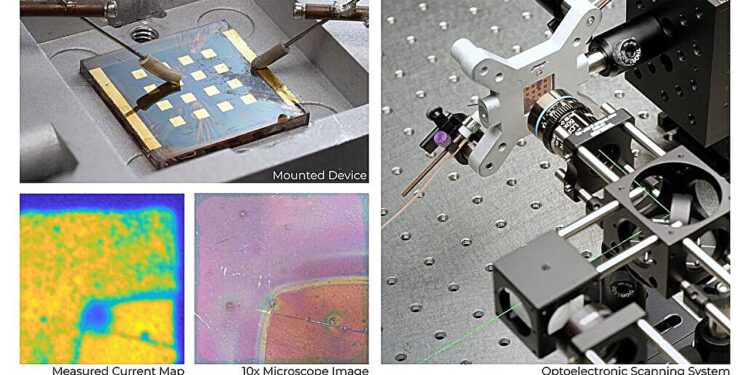In this new method, the scanning instrument (right) is used to measure the current and optical maps (bottom left) of solar cell arrays (top left). Credit: Advanced intelligent systems (2024). DOI: 10.1002/aisy.202400310
The process of testing new solar cell technologies is traditionally slow and expensive, requiring multiple steps. Led by a fifth year doctoral student. student, a Johns Hopkins team developed a machine learning method that promises to dramatically speed up this process, paving the way for more efficient and affordable renewable energy solutions.
“Our work shows that machine learning can streamline the process of testing solar cells,” said team leader Kevin Lee, who worked with fellow electrical and computer engineering graduate students Arlene Chiu, Yida Lin, Sreyas Chintapalli and Serene Kamal, and Eric Ji, undergraduate. on the project. “This not only saves time and resources, but opens up new opportunities for developing clean energy technologies.”
The team’s results appear in Advanced intelligent systems.
A major obstacle to commercializing new solar materials and devices is the long manufacturing-testing-iteration cycle. Optimizing a new solar cell material for the market is an arduous process. Once a device is manufactured, several tedious measurements are required to understand its material properties. This data is then used to adjust the manufacturing process, repeating the cycle.
The new method significantly reduces this time by extracting all important material characteristics from a single measurement. Unlike other methods based on computer-simulated data, which often produce inaccurate results, the Hopkins team’s approach uses real-world data.
Their neural network collects thousands of data points from a single solar cell, capturing complex properties and variations caused by defects, such as spin-cast streaks, cracks and contaminants, and thereby eliminating the need to manufacture thousands of solar cells.
“Kevin’s method has the potential to accelerate the development timelines of photovoltaics,” said Lee’s advisor and study co-author Susanna Thon, associate professor of electrical and computer engineering in the Whiting School of Engineering. JHU and associate director of the university’s Ralph O’Connor Sustainable. Energy Institute.
“Instead of laboriously performing multiple measurements on many devices to learn what you need to know about device behavior, Kevin, through his (machine learning) algorithm, can now tell you anything you would like know about a device and its properties a single measurement which takes approximately 30 seconds.
The other novelty of Lee’s system is that it takes spatial maps of solar cell data and converts them into images.
“Normally, one of the most common measurements you get after creating a new solar cell is called a JV curve, and it measures the cell’s response to light,” Lee said.
“We had the idea to convert these JV curve maps into images so that we could leverage advanced machine learning models developed for applications not in materials science, but in computer vision, to learn behavioral models of solar cells.”
Another advantage of the new method is its applicability to various materials and devices beyond solar cells, potentially speeding up the time from material discovery to market adoption.
“In theory, the system we developed could be used to measure other devices, such as transistors and light sensors,” Lee said. “The time saved and precision of this system could lead to the creation of a wide range of new technologies much more quickly, which I am excited to see happening.”
More information:
Hoon Jeong Lee et al, Parameter prediction of PbS colloidal quantum dot solar cells using neural networks trained on experimental data, Advanced intelligent systems (2024). DOI: 10.1002/aisy.202400310
Provided by Johns Hopkins University
Quote: Engineers develop way to streamline solar cell testing, speeding up a process that can be slow and expensive (October 10, 2024) retrieved October 10, 2024 from
This document is subject to copyright. Except for fair use for private study or research purposes, no part may be reproduced without written permission. The content is provided for informational purposes only.



